MARIANI’S
February
11, 2007
NEWSLETTER

"Blondie" Comic Strip by Young and Drake (February 15, 2004)
WEBSITE: To
go to my web site, in which I will update food
&
travel information and help link readers to other first-rate travel
& food sites, click on: home page
ARCHIVE: Readers may now access
an
Archive of all past newsletters--each annotated--dating back to July,
2003, by simply clicking on www.johnmariani.com/archive
SUBSCRIBE AND UN-SUBSCRIBE:
You may subscribe anyone you wish
to this newsletter--free of charge--by
clicking here.
In
This Issue
Why a Bistro? by John Mariani
NEW YORK CORNER: Gordon Ramsay at the London by John Mariani
THE MILE HIGH CLUB
NOTES FROM THE WINE CELLAR: Aussie Wine Industry is Pumping Up Fast by John Mariani
QUICK BYTES
WHY A BISTRO? by John Mariani

I have only one rule of thumb about arriving in
On my last trip I headed straight for L'Absinthe, a bistro on the Place du Marché
People love bistros because they are small (a brasserie is a much larger Alsatian sub-genre), with an intimacy created by the cunning closeness of their tables. They are often family-owned neighborhood eateries, with the husband in the kitchen and the impeccably dressed wife up front, with a warmth of not found in formal dining rooms.
Bistros are never dark. The walls, dulled by cigarette smoke, are usually a warm yellow, the mirrors tilted to give the room depth and a reflected light and an opportunity to flirt with someone at the table behind yours. The banquettes are almost always deep brownish-red, there is usually some frosted glass and brass railings, and the curtains are usually fine lace. The food is always simple and full of flavor, with certain classics dependably on the menu, like onion soup, confit of duck with garlic potatoes, creamy brandade of cod and caramelized apple tart Tatin. The typography and purple ink on the menus seems almost sacrosanct.
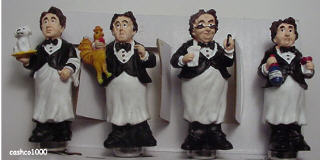 The universal appeal of the
French
bistro
has caused a boom that's fanned out from Paris, where the old standbys
like Chez Georges (which has
the best beef and leg of lamb) and L'Ami
Louis
(whose
foie gras and roast chicken are paragons of their form) still thrive,
while places like L'Absinthe, Les
Bookinistes and Rôtisserie
d'en Face are
owned by
star chefs and booked weeks in advance with people much happier paying
$40-$50
at a bistro than $200 at a pretentious, deluxe restaurant.
The universal appeal of the
French
bistro
has caused a boom that's fanned out from Paris, where the old standbys
like Chez Georges (which has
the best beef and leg of lamb) and L'Ami
Louis
(whose
foie gras and roast chicken are paragons of their form) still thrive,
while places like L'Absinthe, Les
Bookinistes and Rôtisserie
d'en Face are
owned by
star chefs and booked weeks in advance with people much happier paying
$40-$50
at a bistro than $200 at a pretentious, deluxe restaurant. In the
You bring to a bistro whatever mood you're in, and then you shake it free or stir it up. When you feel gregarious, a bistro buoys you. When you feel blue, the gaiety of the place and the first aperitif brings you back from the brink. The waiters all have stories to tell, but, you think, never about you. And because bistros all share so very much in common, they make you feel hungry and happy and at home, wherever you are in the world.
THE BISTROS
Paris:
-L'Absinthe--24 Place du Marché-Saint-Honoré; 01-49-26-9004.
-Chez Georges--1 Rue de Mail; 01-42-60-0711.
-Aux Lyonnais--32 Rue Saint-Marc; 01-42-96-6504.
-L'Ami Louis--32 Rue du Verbois; 01-48-87-7748.
L'Ami Jean--27 Rue Malar; 01-47-05-8689.
La Régalade--49 Avenue Jean-Moulin; 01-45-45-6858.``
-Rôtisserie d'en Face--2 Rue Christine; 01-43-26-4098.
New York:
-La Goulue--746 Madison Avenue; 212-988-8169.
-L'Absinthe--227 East 67th Street; 212-794-4950.
Chez Jacqueline--72 Macdougal Street; 212-505-0727.
-Payard Bistro--1032 Lexington Avenue; 212-717-5252.
-Orsay--1057 Lexington Avenue; 212-517-6400.
USA:
-Bistro Moderne--2525 West Loop South, Houston, TX; 713-297-4383.
-Le Petit Robert--468 Commonwealth Avenue, Boston; 617-375-0699.
-Bistro 110--110 East Pearson Street, Chicago; 312-266-3110.
-Mimosa--8009 Beverly Boulevard, Los Angeles; 323-655-8895.
-Bistro Jeanty--6510 Washington Street, Yountville, CA; 707-944-0103.
NEW YORK CORNER
Gordon Ramsay at the London
212-468-8888
www.thelondon.nyc
Gordon Ramsay might well have taken that sentiment to heart as he invaded New York in December with the opening of his namesake restaurant in The London Hotel (formerly the Righa Royal). After becoming London’s Über-chef, with nine restaurants in town, and building an empire that now stretches from there to Dubai and Tokyo, Ramsay may have taken on his biggest challenge yet in a career that has seen him soar over the last five years to extraordinary celebrity and considerable wealth.
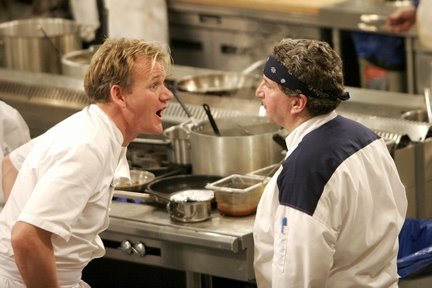
Still, no one would deny that Ramsay is one of London’s great
Just how much Ramsay cooks at
In an interview Ramsay, 40, told me three things that indicate he is very, very serious about making it in New York: 1. It is the only restaurant outside of his London flagship and Claridge's that bears his name, while his other restaurants actively promote the on-premises chef; 2. He will be flying at least twice a month between London and New York to be in both kitchens as much as possible (Chef de Cuisine Neil Ferguson oversees day-to-day operations in New York); 3. He acknowledged that his 45-seat New York restaurant will probably never make a profit, but that it anchors the more casual London Bar, with 135 seats, three salons for private dining, and a Chef’s Table, already at fixture at five of Ramsay’s other restaurants; even a Spa Menu will be offered to guests staying in the hotel.
And so, in mid-December Gordon Ramsay at The London debuted, and New York foodies put it on speed dial, with reservations difficult to come by weeks in advance. After a month or so the reviews started coming in, and they have not been. . . raves. Adam Platt of New York Magazine called it a "glittering bank vault," and wrote, "none of the weary diners at my table had anything horrible to say about their food. On the other hand, no one was babbling with rapturous excitement, either." Alan Richman of Bloomberg News described the room as "a shimmering expression of austerity. . . . You might feel claustrophobic--worse yet, entombed," and the food reminded him of "the French-international cuisine that British chefs turn out whenever they ply their trade aboard cruise ships." Then, two weeks ago, The anxiously awaited New York Times review by Frank Bruni came out: Only two stars ("very good")! Wrote Bruni, "Most ingredients are predictable, most flavors polite, most effects muted. Mr. Ramsay may be a bad boy beyond the edges of the plate, but in its center, he’s more a goody-two-shoes."
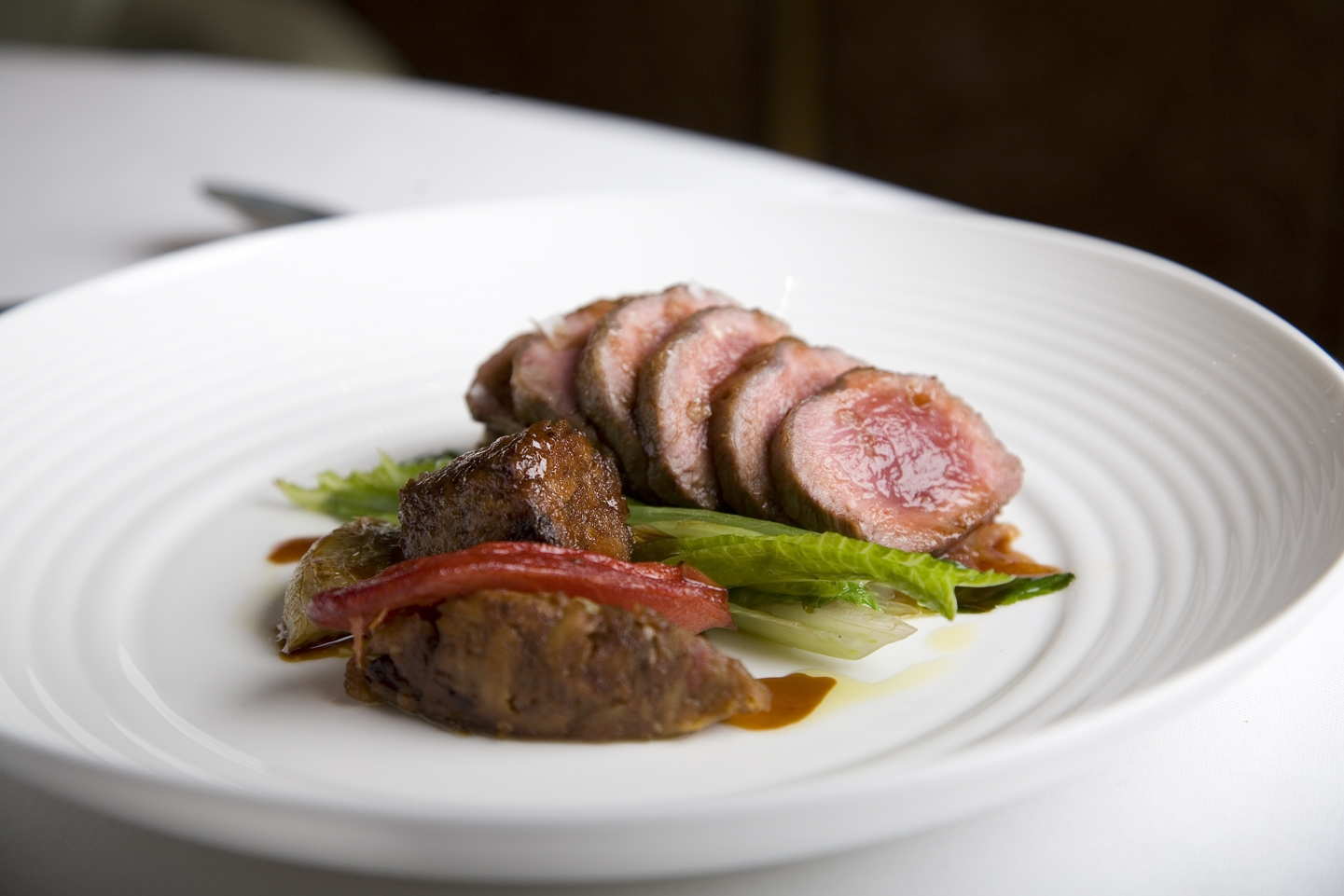 Having now dined twice at Gordon Ramsay at The
London--one dinner, one lunch--I'm afraid I have to agree with my
colleagues. The restaurant has a certain cold elegance, the service by
a multi-national crew is deferential, the price is right, and the food
is very correct. But I can't say I came away wanting more;
neither can I think of many friends who would be dazzled by this decor.
Having now dined twice at Gordon Ramsay at The
London--one dinner, one lunch--I'm afraid I have to agree with my
colleagues. The restaurant has a certain cold elegance, the service by
a multi-national crew is deferential, the price is right, and the food
is very correct. But I can't say I came away wanting more;
neither can I think of many friends who would be dazzled by this decor.I have dined at most of Ramsay's London-based restaurants, including his namesakes on Hospital Road and at Claridge's, as well as at the Mediterranean-inflected MENU at The Connaught and the small-plate Maze. I've never been disappointed at any of them (I like MENU most, but chef Angela Hartnett has decamped to Miami to open a branch for Ramsay there), and I've always felt well fed and well served. None has thrown me into ecstasy, however, nor does the new New York restaurant.
There is, to be sure, much to love on the menu. Among the starters sea scallops with sautéed new potatoes, truffle sauce, and a mixed herb salad was a delightful way to begin, although lobster ravioli poached in its own bouillon with celery root cream (nice touch), shellfish vinaigrette and a chervil velouté was a bit fussy. Very correct in flavor and preparation (though quite salty one night) were caramelized sweetbreads with creamed artichoke, ceps and a cabernet sauvignon sauce. Then it hit me: This is the kind of menu so favored haute cuisine in France as haute cuisine--very soft food, with very little texture, as if guests have neither the teeth nor the stamina to chew on anything. So the accompaniments to a nice piece of turbot poached in St. Émilion were creamed potatoes, braised salsify, braised baby leeks and a civet sauce that overpowered the delicacy of the fish.
Better in that it had a crispy skin, was pan-fried daurade in a nicely assertive gastrique with Serrano ham, though the corn succotash was soft too. Very fine, very juicy chicken, roasted to a turn on the bone, had an honorable marriage with a fricassée of bacon, onions, and prunes, with yet another purée, this time made from sunchokes. Roast cannon of lamb with a confit of the shoulder (above) came with candied onions and a marjoram jus, along with a Turkish side dish, Imam Bayildi, made from eggplant stuffed with onions, garlic, and tomato, very tasty and very soft.
Desserts are good, if not among the most exciting in New York--pain perdu with baked apple, cherries, and pistachio ice cream; a simple and very good chocolate fondant with milk ice cream (below), and textbook apricot soufflé with amaretto ice cream.
In the end, it may well be that "textbook" quality of Ramsay's cooking--impeccable, classic, conservatively stylish--that is the problem here. Little of his food reaches the heights of so many, many dishes you find routinely at Jean-Georges, Daniel, Le Bernardin, Eleven Madison Park and Per Se--not to mention the work of great American chefs like Alfred Portale at Gotham Bar & Grill, Shea Gallante at Cru, Terrance Brennan at Picholine, and so many others. Dining at Gordon Ramsay is like going to dinner at a very proper, sedately tasteful London house with a French-trained chef and coming away truthfully telling your hostess you had a perfectly lovely time. But you don't really look forward to returning any time soon.
The formal dining room is open for lunch and dinner daily, and the London Bar for breakfast, lunch, tea, and dinner daily. At the Bar small plates run $12-$18, four courses $55, six courses $75.
THE MILE HIGH CLUB
Perusing flight attendants' website www.airlinecrew.net can sometimes reveal more about our favorite celebrities than People Magazine. Here are what some flight attendants have said about their glittering stars onboard.
Jennifer Lopez reportedly yelled at an attendant "because I couldn't make her double espresso and then told me my shoes were cheap." On a flight from LAX-MIA: "Boy is her A$$ big, but not as big as her head. She
 scolded
me
when I
refused to leave the aircraft and purchase some magazines for her.
Guess she's
too frugal to have an assistant travel with her."
scolded
me
when I
refused to leave the aircraft and purchase some magazines for her.
Guess she's
too frugal to have an assistant travel with her."

William Shatner was spotted as a passenger who "throws his chocolate wrappers all over the floor."

Joan Collins "should be made to check her Ego in before boarding the plane."
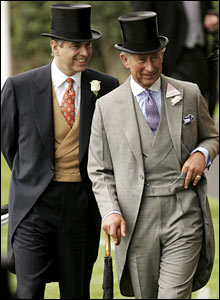
Prince Andrew "blows hot and cold. One minute can appear nice enough, the next, treats you like a moron.
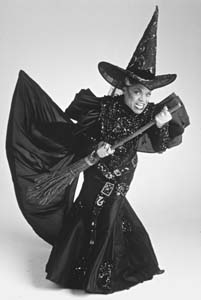
Eartha Kitt: "A bit bonkers, I think."
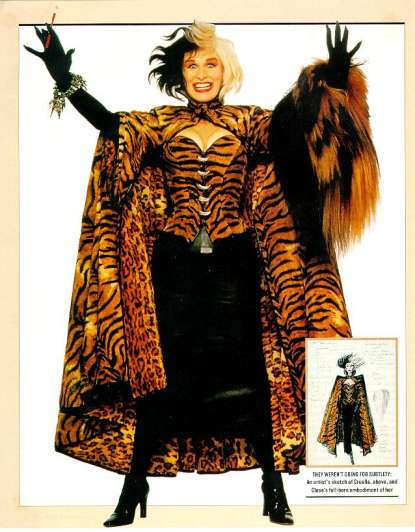
Glen Close: "Stuck up, ugly woman. Acted as if we were about to beg and plead for her tired autograph."
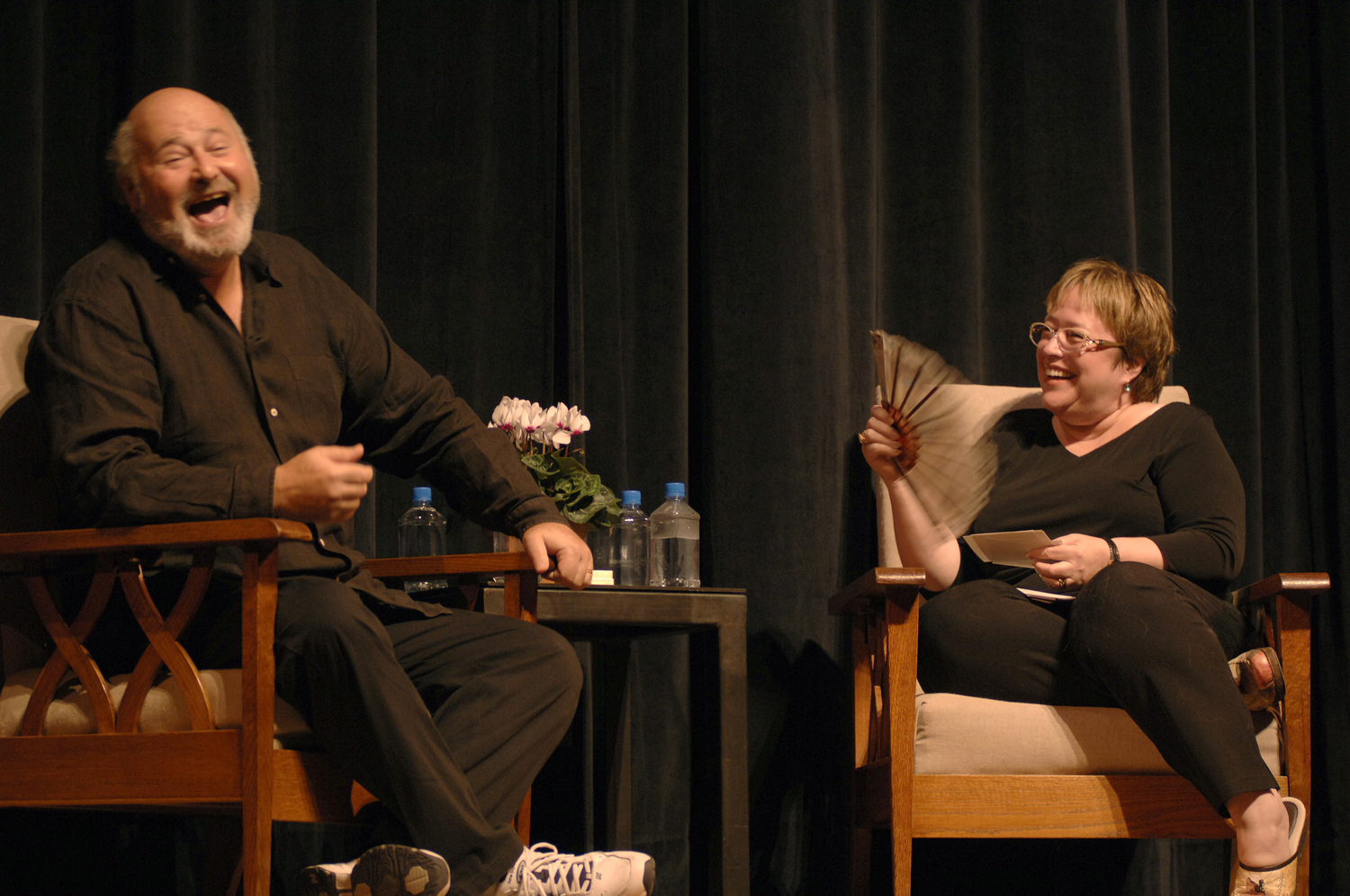
Rob Reiner (with kids, wife and maid): "They took up the entire First Class on that 767. OK attitude, but VERY messy. Left trash everywhere on that flight."

Barbara Walters: "Very snobby chick. Would cut her eyes at ya if you even looked her way."

Whitney Houston: "When she was confronted by Captain about smoking in the bathroom and told that she could be fined $2,000, she calmly asked who to make the check payable to."

Gwen Stefani: "Nice but rally haggard, like she had just thrown up something."
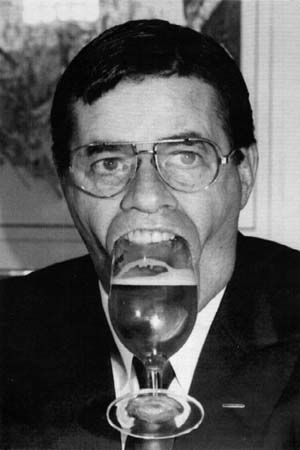
Jerry Lewis: "Complete and utter idiot! Rude, crude. I now change channels whenever he's on. Ditto for comedian Alan King."

George Michaels: "Some years ago, traveling with his wife or girlfriend or whatever she was meant to be (handbag, in fact!), he was an arrogant ill-mannered pig who grunted at the crew. Perhaps hanging around public toilets has made him more humble! (and approachable?).

Boris Becker: At the door to flight attendant on boarding: "I don't want to be disturbed. I don't give autographs. I'll let you know if I want something!" What's your problem?
NOTES FROM THE WINE CELLAR

Aussie Wine Industry is Pumping Up Fast
by John Mariani
Australian winemakers came to
Already the sixth largest wine producer in the world,
“In ten years
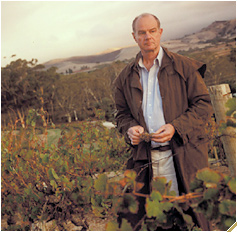 Laffer, 66, (below) came aboard in 2002 at Jacob’s
Creek , which produced its first red wines in 1973, and today he
claims 2
million glasses of the company’s wines are drunk every day around the
world. In
fact, Jacob’s Creek, owned by Orlando Wines, a subsidiary of Pernod Ricard Pacific Pty Ltd., is now the
best-selling brand
in
Laffer, 66, (below) came aboard in 2002 at Jacob’s
Creek , which produced its first red wines in 1973, and today he
claims 2
million glasses of the company’s wines are drunk every day around the
world. In
fact, Jacob’s Creek, owned by Orlando Wines, a subsidiary of Pernod Ricard Pacific Pty Ltd., is now the
best-selling brand
in Laffer, who originally wanted to be a veterinary surgeon (his father said he wasn’t bright enough), now oversees 20 winemakers for Orlando, spending much of his time shuttling from Australia to Japan, the U.S., and the U.K. marketing his wines when not tending and blending them at the wineries.
With more than 20 years in the business, Laffer has experienced the unparalleled growth of
Overseeing production at such an enormous wine company as
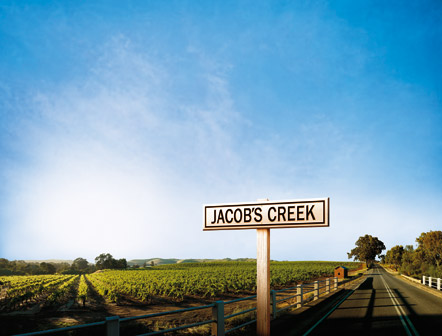
I asked Laffer if the key to the Australian wines’ success is that they tend to be extremely fruity, the whites highly tropical and somewhat sweet, the reds overextracted and high in alcohol. “That’s changing, thank God,” he insisted. “The Australian press is down, down, down on high alcohol wines, and [at Jacob’s Creek] we don’t want our wines to exceed 14 percent alcohol.”
On the issue of cork closures versus screwtops, which many Australian and
Where does Laffer see even further growth in consumption coming from? “Believe it or not,
QUICK BYTES
Owing to the huge number of press releases on holidays dinners like St. Valentine's Day, it is only possible to list a very few extraordinary events and packages.
* On Feb. 26, Chefs Lisa and Jeremy Sewall of Lineage in Coolidge Corner, Brookline, MA, will be joined by Chefs Ming Tsai of Blue Ginger and Michael Schlow of Radius, Alta Strada and Great Bay to kick off the restaurant’s first anniversary with a 4-course.meal paired with wines, with proceeds from the $175 pp dinner to the Jill Edmonds Memorial Scholarship. Call 617-232-0065’ www.lineagerestaurant.com
* On Feb. 27 at NYC’s Pier Sixty, Lidia Bastianich, Co-owner of Felidia, Becco, Esca and Del Posto in NYC, Lidia’s Kansas City and Lidia’s Pittsburgh, and host of “Lidia’s Family Table” on APTV, will be given a birthday party that will incl. a Grand Walk-Around-Tasting by 36 of NYC’s chefs, with Champagne and wine from the Kobrand Foundation; Silent Auction of Culinary and Travel Packages; Tix at $450, $600, and $1,000. Call 212-974-7111.
* On the first Tuesday in 2007spring and summer, the Summer Lodge Country House Hotel, Restaurant and Spa, in Evershot, Dorset, will feature Chef Steven Titman and Sommelier Eric Zwiebel in its Summer Lodge Wine Dinners. March 5—
* On March 3 & 4, the first-ever Food University™ will take place at the
~~~~~~~~~~~~~~~~~~~~~~~~~~~~~~~~~~~~~~~~~~~~~~~~~~~~~~~~~~~~~~~~~~~~~~~~~
MARIANI'S VIRTUAL GOURMET NEWSLETTER is published weekly. Editor/Publisher:
John Mariani. Contributing Writers: Robert Mariani, Naomi
Kooker, Kirsten Skogerson, Edward Brivio, Mort
Hochstein, Suzanne Wright. Contributing
Photographers: Galina Stepanoff-Dargery, Bobby Pirillo. Technical
Advisor: Gerry McLoughlin.
Any of John Mariani's books below
may be ordered from amazon.com by clicking on the cover image.
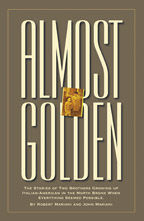 My
newest book, written with my brother Robert Mariani, is a memoir of our
years growing up in the My
newest book, written with my brother Robert Mariani, is a memoir of our
years growing up in the For those of you who don't think of the Robert and I think you'll enjoy this very personal look at our --John Mariani |
 |
 |
 |
 |
 |
 |
copyright John Mariani 2007
